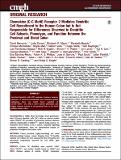Por favor, use este identificador para citar o enlazar a este item:
http://hdl.handle.net/10261/157867COMPARTIR / EXPORTAR:
 SHARE SHARE
 CORE
BASE CORE
BASE
|
|
| Visualizar otros formatos: MARC | Dublin Core | RDF | ORE | MODS | METS | DIDL | DATACITE | |

| Título: | Chemokine (C-C motif) receptor 2 mediates dendritic cell recruitment to the human colon but is not responsible for differences observed in dendritic cell subsets, phenotype, and function between the proximal and distal colon |
Autor: | Bernardo, David CSIC ORCID CVN; Mann, Elizabeth R.; Montalvillo, Enrique CSIC; Fernández-Salazar, Luis; Garrote, José Antonio CSIC ORCID CVN; Al-Hassi, Hafid O.; Arranz, Eduardo CSIC ORCID; Knight, Stella C. | Palabras clave: | Distal colon Dendritic cells CCR2 Human gastrointestinal tract Microbiota Proximal colon |
Fecha de publicación: | 2016 | Editor: | Elsevier | Citación: | Cellular and Molecular Gastroenterology and Hepatology 2(1): 22-39.e5 (2016) | Resumen: | [Background & Aims]: Most knowledge about gastrointestinal (GI)-tract dendritic cells (DC) relies on murine studies where CD103 DC specialize in generating immune tolerance with the functionality of CD11b subsets being unclear. Information about human GI-DC is scarce, especially regarding regional specifications. Here, we characterized human DC properties throughout the human colon. [Methods]: Paired proximal (right/ascending) and distal (left/descending) human colonic biopsies from 95 healthy subjects were taken; DC were assessed by flow cytometry and microbiota composition assessed by 16S rRNA gene sequencing. [Results]: Colonic DC identified were myeloid (mDC, CD11cCD123) and further divided based on CD103 and SIRPα (human analog of murine CD11b) expression. CD103SIRPα DC were the major population and with CD103SIRPα DC were CD1cILT3CCR2 (although CCR2 was not expressed on all CD103SIRPα DC). CD103SIRPα DC constituted a minor subset that were CD141ILT3CCR2. Proximal colon samples had higher total DC counts and fewer CD103SIRPα cells. Proximal colon DC were more mature than distal DC with higher stimulatory capacity for CD4CD45RA T-cells. However, DC and DC-invoked T-cell expression of mucosal homing markers (β7, CCR9) was lower for proximal DC. CCR2 was expressed on circulating CD1c, but not CD141 mDC, and mediated DC recruitment by colonic culture supernatants in transwell assays. Proximal colon DC produced higher levels of cytokines. Mucosal microbiota profiling showed a lower microbiota load in the proximal colon, but with no differences in microbiota composition between compartments. [Conclusions]: Proximal colonic DC subsets differ from those in distal colon and are more mature. Targeted immunotherapy using DC in T-cell mediated GI tract inflammation may therefore need to reflect this immune compartmentalization. | Descripción: | Open Access funded by Biotechnology and Biological Sciences Research Council. Under a Creative Commons license.-- et al. | Versión del editor: | https://doi.org/10.1016/j.jcmgh.2015.08.006 | URI: | http://hdl.handle.net/10261/157867 | DOI: | 10.1016/j.jcmgh.2015.08.006 | Identificadores: | doi: 10.1016/j.jcmgh.2015.08.006 e-issn: 2352-345X |
| Aparece en las colecciones: | (IBGM) Artículos |
Ficheros en este ítem:
| Fichero | Descripción | Tamaño | Formato | |
|---|---|---|---|---|
| C-C Motif.pdf | 6,1 MB | Adobe PDF |  Visualizar/Abrir |
CORE Recommender
PubMed Central
Citations
16
checked on 17-abr-2024
SCOPUSTM
Citations
25
checked on 21-abr-2024
WEB OF SCIENCETM
Citations
25
checked on 28-ene-2024
Page view(s)
309
checked on 23-abr-2024
Download(s)
217
checked on 23-abr-2024

